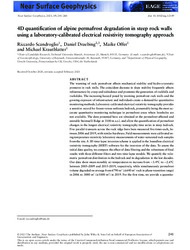4D quantification of alpine permafrost degradation in steep rock walls using a laboratory‐calibrated electrical resistivity tomography approach
Scandroglio, Riccardo; Draebing, Daniel; Offer, Maike; Krautblatter, Michael, 2021: 4D quantification of alpine permafrost degradation in steep rock walls using a laboratory‐calibrated electrical resistivity tomography approach. In: Near Surface Geophysics, Band 19, 2: 241 - 260, DOI: 10.23689/fidgeo-4354.
 |
Dokument öffnen: |
The warming of rock permafrost affects mechanical stability and hydro‐cryostatic pressures in rock walls. The coincident decrease in slope stability frequently affects infrastructure by creep and subsidence and promotes the generation of rockfalls and rockslides. The increasing hazard posed by warming permafrost rock walls and the growing exposure of infrastructure and individuals create a demand for quantitative monitoring methods. Laboratory‐calibrated electrical resistivity tomography provides a sensitive record for frozen versus unfrozen bedrock, presumably being the most accurate quantitative monitoring technique in permafrost areas where boreholes are not available. The data presented here are obtained at the permafrost‐affected and unstable Steintaelli Ridge at 3100 m a.s.l. and allow the quantification of permafrost changes in the longest electrical resistivity tomography time series in steep bedrock. Five parallel transects across the rock ridge have been measured five times each, between 2006 and 2019, with similar hardware. Field measurements were calibrated using temperature‐resistivity laboratory measurements of water‐saturated rock samples from the site. A 3D time‐lapse inversion scheme is applied in the boundless electrical resistivity tomography (BERT) software for the inversion of the data. To assess the initial data quality, we compare the effect of data filtering and the robustness of final results with three different filters and two time‐lapse models. We quantify the volumetric permafrost distribution in the bedrock and its degradation in the last decades. Our data show mean monthly air temperatures to increase from −3.4°C to −2.6°C between 2005‒2009 and 2015‒2019, respectively, while simultaneously permafrost volume degraded on average from 6790 m3 (±640 m3 rock in phase‐transition range) in 2006 to 3880 m3 (±1000 m3) in 2019. For the first time, we provide a quantitative measure of permafrost degradation in unstable bedrock by using a temperature‐calibrated 4D electrical resistivity tomography. Our approach represents a fundamental benchmark for the evaluation of climate change effects on bedrock permafrost.
Statistik:
ZugriffsstatistikSammlung:
This is an open access article under the terms of the Creative Commons Attribution‐NonCommercial‐NoDerivs License, which permits use and distribution in any medium, provided the original work is properly cited, the use is non‐commercial and no modifications or adaptations are made.

